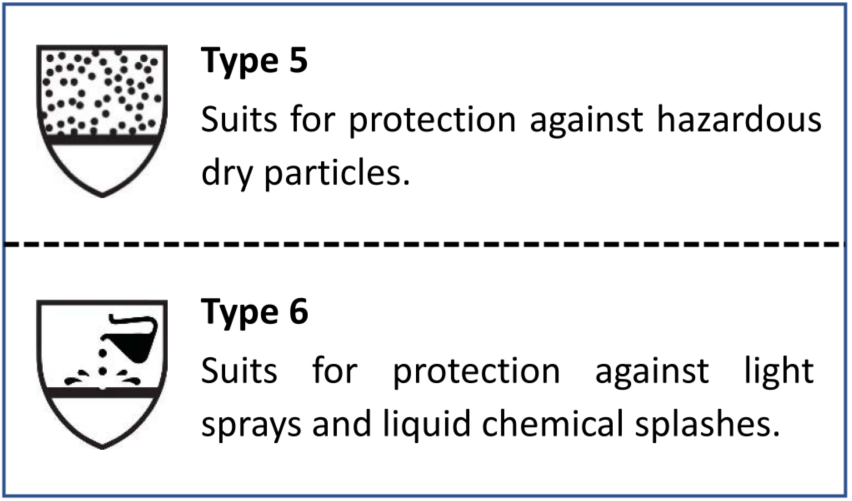There are different Type 5 and Type 6 CE-certified protective clothing on the market. Some of them have the best economic option, while others claim better protection feature. Users shall therefore make an extra effort to find an appropriate protective clothing among a wide range of options. Are there any tips to choose which protective clothing is the appropriate one for you?
There are 2 facts below that you should first know before selecting appropriate Type 5 and Type 6 protective clothing.
- Protection Purpose
This is the essential part. When you first select Type 5 and Type 6 protective clothing, do you know that Type 5 and Type 6 certifications are applied for different protection purposes and scenarios? A quick introduction to these 2 certifications is provided below.
Type 5 Certification: Dry Particle Suits
Based on Regulation EN ISO 13982-1:2004 + A1:2010, the performance requirements for chemical protective clothing include full body protection against airborne solid particles.
Type 6 Certification: Reduced Spray Suits
Based on Regulation EN 13034:2005 + A1:2009, the performance requirements for chemical protective clothing involve limited protection against liquid chemicals.
 |
| Picture 1: Brief Introduction of Type 5 and Type 6 Protective Clothing |
Certifications of Type 5 and Type 6 are applied for various protection purposes and coverage of protective clothing. Type 6 coverall is more fitting if you are suffering a hazardous liquid spray risk environment. On the other hand, Type 5 coverall should then be considered if the environmental risk is related to harmful particulate matter.
- Fabric Structure
The fabric used for protective clothing is different in order to obtain protection for different purposes. In Type 5 and Type 6 certified protective clothing, there are two common fabric options in the market, one is Multi-layer SMS fabric, while the other is PP nonwoven with a Laminated Film.
The Multi-layer SMS fabric is a good choice for the protection of particulates. It has minimum 3 layers, and the middle layer, which provides good particulate filtration is known as melt-blown. The fabric also usually provides good air permeability. For the wording SMS, it is the combination of fabric structures, which is Spunbond (S), Melt-blown (M) and Spunbond (S). Some suppliers may offer different combinations, namely SMMS or SMMSSMS. But after all, it is the melt-blown layer provides filtration features on hazardous particulates.
The other common fabric in the market is “Laminated Film on PP nonwoven”. With the microporous film, it provides protection against liquid or fluid penetration, such as water drip, mud, liquid spray or splash. It usually provides better protection for both particulate and liquid hazards compare with SMS fabric. Depending on the film formula and material technology, not only as a liquid barrier, while the microporous film also let the air or moisture can go through.
 |
| Table 1: Comparison between Multi-layer SMS and laminated film |
On the other hand, if only limited liquid spray risk and hazardous particles are the main risks you are dealing, multi-layer SMS fabric coverall may be sufficient for you as you will appreciate its’ premium breathable wearing experience.As above comparison chart, protective clothing made by laminated film fabric is a better choice than Multi-layer SMS fabric in protection for both liquid and particles, especially when you are dealing with the risk in more liquid form.
Additional Certifications
In addition to particulate and liquid protection, some additional protection marks may be identified on protective clothing. To solve these ever-changing situations in the workplace, here are several additional certifications needed to be attended to.
|
|
 |
 |
 |
| EN 14126 | EN 1073-2 | EN 1149-5 | DN32781 |
- EN 14126:2003 Against Biological Hazards
It is a key standard for medical and disease control purposes in the workplace. The standard defines a set of specifications that requires 5 methods of testing to measure the fabric. These 5 different tests are included in the certification, and 4 out of 5 tests are tested in liquid form. Most SMS products cannot meet this standard. Only laminated film products are available.
- ISO 16603: Resistance to penetration by blood/fluids
- ISO 16604: Resistance to penetration by blood-borne pathogens
- ISO 22610: Resistance to wet microbial penetration
- ISO/DIS 22611: Resistance to liquid aerosol penetration
- ISO 22612: Resistance to dry microbial penetration
- EN 1073-2:2002 Against Radioactive Contamination
The standard has been developed to be applied to the nuclear industry without protection against ionizing radiation. With the whole suit particle protection level, the inward leakage test determines the barrier efficiency of the suit when the defined particulate size is challenged. - EN 1149-5:2018 Anti-Static
The standard specifies a set of requirements and test methods for assessing the protection of the fabric against static electricity or decay. The anti-static ability can be added to both types of fabric structures. The electrostatic resistance is required when the wearer is exposed to conditions where the sparks could cause explosions or ignition. - DIN 32781:2010 Against Pesticides
The test standard applies to chemical penetration, fabric strength and ergonomic criteria. It includes EN 14786, which simulates liquid drug spraying. 5 different pesticides are tested to ensure full safety against pesticides, including U46-D-Fluid (BASF), Pirimor Granulat (Syngenta), Amistar (Syngenta), Betanal Expert (Bayer) and Folicur (Bayer). Some laminated film fabric coveralls in the market do meet and offer this standard for those agriculture application users.
Choose an Appropriate Type 5 and Type 6 Protective Clothing
After reviewing the above 2 facts and the requirement for additional certifications, you will be aware of the details to be focused on Type 5 and Type 6 protective clothing.
The advantages of protective clothing made of Laminated Film are better protection in both liquid and particulates. Therefore, it can be adopted under most working conditions. However, if the breathability is more concerned and the work risk assessment does not require the protection of premium liquids and particulates, the Multi-layer SMS fabric may be more suitable for this situation.
The structure of the fabric should not be the only factor in the selection of protective clothing, additional certifications are just as important. Please keep in mind that knowing the risk you are dealing with before entering the workplace is crucial. Then choose an appropriate coverall to protect yourself to make sure you could go home safely.


